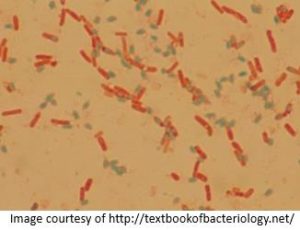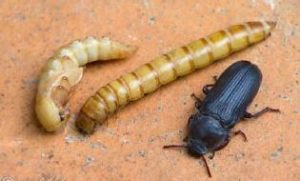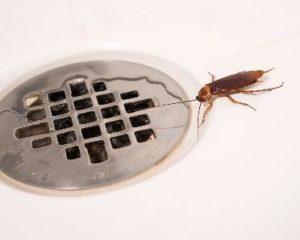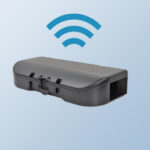Introduction to Bacillus cereus

Bacillus cereus is a toxin-producing anaerobic gram-positive bacterium. The bacteria are commonly found in the environment and can contaminate food. B. cereus can quickly multiply at room temperature with an abundantly present preformed toxin. This toxin can cause gastrointestinal illness when ingested, which is the commonly known manifestation of the disease. A variety of foods, particularly rice and leftovers, as well as sauces, soups, and other prepared foods that have sat out too long at room temperature are sources of B. cereus.
The duration of illness is typically around 24 hours with symptoms including vomiting, nausea and diarrhea, common “food poisoning” symptoms. Keeping foods out of the danger zone is important in prevention, especially if the if food is to be stored longer than two hours (keep hot foods hot (over 140°F) and cold foods cold (40°F or under). Cooked food should be stored in a wide, shallow container and refrigerate as soon as possible.
(More information available from the NCBI)
Submitted by: Rich Gibson ACE, CFSQA
The Yellow Meal Worm

Order: Coleoptera Family: Tenebrionidae Genus: Tenebrio
Mealworms are among some of the largest insect pests of stored products. The common name is derived from the color of the wireworm-like larvae. Yellow mealworms are in the genus Tenebrio, meaning “darkness,” owing to the nocturnal habits of the larvae. The adult is a polished dark brown or black beetle about one-half inch long. Its thorax is finely punctured, and its wing covers are longitudinally striated or grooved. There is only one generation each year.
Mealworms have generally been considered pests because their larvae feed on stored grains. Mealworms probably originated in the Mediterranean region but are now present in many areas of the world, spread by human trade and colonization.
Prevention is the best strategy to avoid insect problems in stored grains. Before grain is placed in a bin it should be screened to eliminate fine materials and broken kernels. Grain placed in a clean bin should be checked at two-week intervals during warm months and at one-month intervals during cooler months for the presence of hot spots, moldy areas, and live insects. If any of these conditions exist, the grain should be aerated to lower the moisture level and temperature. If infestation occurs in spite of these precautions, fumigation of the grain will be necessary.
Submitted by: Rich Gibson, ACE, CFSQA
Pests & Pandemic

American cockroaches live primarily outdoors, but it is not uncommon to find them inside a structure. In the Northern United States, American cockroaches are typically found in sewers and drains. In fact, American cockroaches are the most common cockroach species found in city sewer systems. It’s been reported that more than 5,000 individual American cockroaches were found in a single sewer manhole in New York City. During warmer summer months it is common to see these insects on sidewalks and on streets in large metropolitan areas.
American cockroaches will move indoors when they experience a food shortage or a significant change in climate. American cockroaches prefer warm and dark environments with temperatures between 70-80 degrees Fahrenheit. They often enter structures by being brought in on human belongings, coming up the sewer systems via drains or occasional mass migration from other structures, dumps, etc. during warm weather.
American cockroaches are especially common in larger commercial buildings such as bakeries, supermarkets, food processing plants, hospitals and hotels. In these facilities they often infest food storage and prep areas, boiler rooms, steam tunnels and basements. American cockroaches feed on many kinds of food, but they show a particular fondness for fermenting material. Outdoors they eat decaying leaves, fungi, algae and small insects. Indoors, they eat any food debris and crumbs found under and behind appliances, in drains, behind kitchen cabinets and on the floor.
Due to the Covid-19 pandemic many large densely populated urban areas and cities are experiencing a decrease in population. As people move to the suburbs and rural areas to avoid the risk of exposure to the virus there has been a tremendous effect on the existing infrastructure in urban locales. One of the most important results regarding pest activity has been observed with rodents and subterranean insects including American roaches.
Rats in the New York City area are becoming more aggressive as their food supply has diminished due to businesses (restaurants and food establishments) closing. Rodents are foraging greater distances to obtain their food supply. Transit systems (subways) have traditionally generated a large supply of food for rodents (in addition to shelter and water). With the total shut down and now decreased ridership the rodents are stressed and sightings even during the day have increased as the rats adjust to the limited supply of food below ground.
American cockroach activity has also been affected by the changes which have occurred due to the pandemic. These subterranean insects thrive in the sewer systems of large densely populated urban areas. Prior to the pandemic the sewer systems were constantly overtaxed and pushed sometimes beyond capacity. The decrease in population has resulted in waste and water levels significantly dropping within the sewer systems. As levels dropped the insects are emerging and moving upwards into buildings plumbing, storm drains, electrical conduits, and water supply lines. This is primarily a survival instinct as the American cockroaches’ forage for a food source.
- Lessons Learned:
• Senior Management Commitment comes first
• Teamwork Makes the Dream Work
• Systematic approaches are key
Submitted by: Chris Sweezy
Region Director, East
RK Environmental Services














